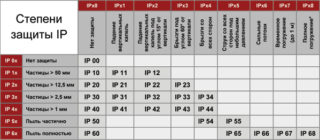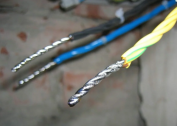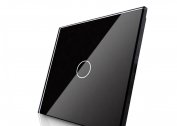In urban illumination, lighting of sidewalks, parks, stadiums, playgrounds, adjoining territories and garden paths, LED lamps have proved to be no worse than indoors. Slowly LED modules survive sodium and halogen lamps due to their cost-effectiveness. Low power consumption of LEDs pays for replacing lamps in street lamps in 2-3 years.
Design and use of street LED illuminators
The difference between external and internal luminaires in complicated operating conditions. The tasks of artificial lighting outside the walls of buildings are divided into basic and decorative.
The basic (lighting) is the provision of visibility on roadways, squares, stadiums, adjoining sections and other territories where human activity does not stop completely in the dark. For this purpose, an LED board is used, placed in a metal case. The luminaire is equipped with vertical heat dissipating fins, a scattering screen and a driver for converting the incoming voltage.
Directional light sources are called spotlights. Their sizes range from a light bulb above the porch of a country house to a stadium giant.
Diffused light is given by lanterns on sidewalks, square paths, terraces.
Decorative lighting presented:
- architectural - illumination of facades, signboards, urban sculpture, murals and other accents with light;
- landscape - decoration of trees, participation in the composition of plantings, design element of gardens and parks.
The dimensions of LED elements allow you to create grids and ribbons for decoration. Outdoor advertising is not complete without LEDs.
Duralight is a flexible PVC tube in which the gaps between the diodes are filled with polymer. Water resistance, durability and resistance to UV radiation allows the tape not to be afraid of the sun, rain and mechanical damage. Power consumption is limited to a range of 16 - 26 W / m. The cord has a round or rectangular cross section. The ultra-thin duralight is called duralex.
The strip consists of single-color diodes or is made in RBG technology (of red, blue, green crystals). In many models, there is a change in the static and dynamic modes of illumination. The device is controlled through the controller, often using a remote control.
Outdoor Lighting Performance
The choice of lighting equipment is determined by the calculated values, which are determined by the formulas of regulatory documents.
The protection class determines the conditions of humidity and pollution of the environment for the installation of the lamp. In the IPXX marking, the first digit indicates the degree of dust penetration (X = 0 ... 6), the second - moisture (X = 0 ... 8). Outdoor lighting starts from IP43, IP44 for wall-mounted appliances, IP65 - dug in and fixed on poles.
The luminous flux depends on the specified SNiP 23-05-2010 necessary according to the functionality of the horizontal illumination of the territory. The venues for public events suggest up to 20 lux, walking paths in the historic center of the city, playing areas - 10 lux, for secondary alleys of the parks 1 lux is enough.
Lux - the amount of light that falls on a unit of horizontal surface area (lm / m2). Lumen is the power of the outgoing light flux. It decreases inversely with the height of the source.The level of lighting, the plan for the placement of projectors and lamps on significant areas (for example, roads) is carried out by special institutions using several regulatory indicators. In everyday life, you can do with a simplified scheme, an online calculator.
Luminous efficiency - the light power that the device gives out for 1 W of energy consumed. The higher the indicator of the model, the more cost-effective its use. The average range for LED streetlights is 80–100 lm / W, which is 2–2.5 times higher than that of sodium lamps.
Additional parameters affect the selection of suitable equipment.
- The color of the radiation. The human eye is friendly to the shade of the white color temperature of 3000-6000 K. It is achieved by setting and simultaneously turning on the colored LED elements or painting or combining a blue diode with a yellow phosphor.
- Built-in touch sensors respond to movement, illumination, noise, allow you not to waste energy idle.
- Dimming is not available for all LED lamps. If you need to adjust the brightness at the installation site, it is worth considering models with special soles.
The manufacturer indicates the service life in the number of working hours (50-100 thousand hours), but the actual period of suitability depends on the removal of heat and the uniformity of the voltage in the network.
Pros and cons of LEDs
 The market of LED lamps for outdoor lighting is growing every year, but they have their positive and negative sides, like any product. Of the advantages it is worth highlighting:
The market of LED lamps for outdoor lighting is growing every year, but they have their positive and negative sides, like any product. Of the advantages it is worth highlighting:
- economical use due to the high current consumption for luminescence and the minimum for heating;
- long period of operation (~ 50 thousand hours) and independence on the number of device on / off;
- devices do not contain harmful substances, which means they are safe for the environment and humans;
- the design provides a high class of protection against mechanical damage and atmospheric influences;
- produce light that is comfortable for vision, the color rendering coefficient reaches 0.9;
- it is possible to avoid flicker and noise when the lamps work;
- easy to carry out installation in a domestic environment.
Street LED lighting was not without drawbacks:
- high price - a relative minus, more investment for 15-20 years of using the lamp;
- afraid of high temperatures, therefore, for baths and saunas, as well as next to heating installations, it is better to choose other options;
- gradual loss of brightness, which can be slowed by heat dissipation.
The prevalence of pluses over minuses explains why LED street lighting is more and more common than halogen and with incandescent lamps.
LED streetlights are presented on the market by imported (Samsung LED, Philips-Lumileds, etc.) and domestic (LLC Ledel) manufacturers. Before buying, you should ask what the supplier’s reputation is, to check the availability of a passport and a warranty card for the device.








